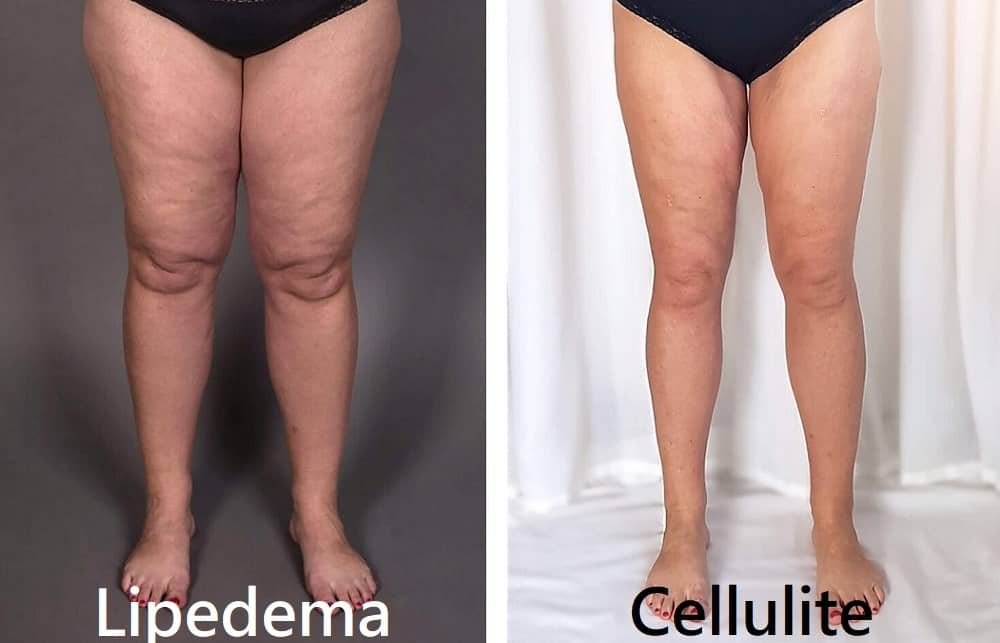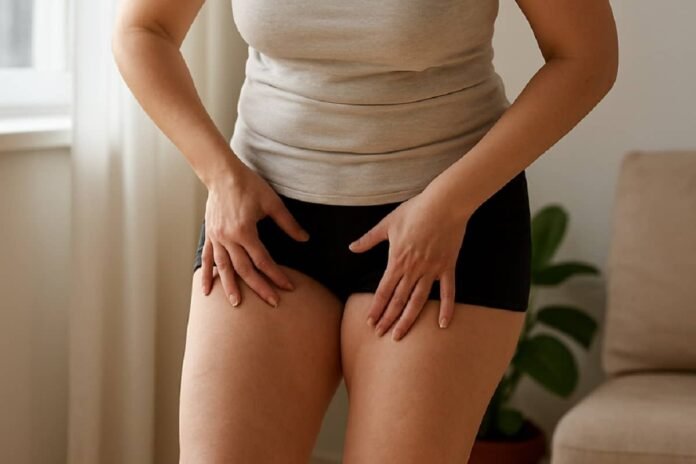Why People Confuse Lipedema and Cellulite
It’s easy to mistake lipedema for cellulite—both can cause uneven, dimpled skin and appear on the thighs or hips. But beneath the surface, these two conditions are quite different. One is a cosmetic skin issue (cellulite), while the other is a medical disorder involving fat and lymphatic tissue (lipedema).
Understanding the difference between lipedema vs cellulite is more than just a vanity concern—it can influence your health, comfort, and confidence. Women who unknowingly live with lipedema often struggle with pain, swelling, and stubborn fat deposits that don’t respond to diet or exercise. Recognizing the symptoms early can help you seek the right treatment.
Let’s break down what makes each condition unique, how to tell them apart, and what medical experts recommend for recovery and self-care.
What Is Lipedema? Understanding the Condition

Lipedema is a chronic, progressive fat disorder that primarily affects women. It causes a symmetrical buildup of fatty tissue—most commonly in the legs, thighs, hips, and sometimes arms—while sparing the hands and feet. The result is a disproportionate lower body shape that often feels painful or heavy.
Symptoms of Lipedema:
- Bilateral (even on both sides) swelling in the legs or arms
- Skin that feels tender or painful to touch
- Easy bruising
- Fat deposits resistant to diet or exercise
- A clear line between normal and affected areas (often around the ankles or wrists)
Unlike obesity, lipedema is not caused by overeating or inactivity. It has hormonal and genetic roots, often emerging after puberty, pregnancy, or menopause. According to the Cleveland Clinic, lipedema affects up to 11% of women worldwide and is frequently underdiagnosed.
Left untreated, lipedema can lead to mobility issues, psychological stress, and secondary lymphedema (fluid buildup).
What Is Cellulite? The Cosmetic Skin Concern
Cellulite, on the other hand, is a common and harmless skin condition where fat deposits push through connective tissue beneath the skin. This causes the familiar “orange-peel” or dimpled texture—most noticeable on thighs, buttocks, and abdomen.
Cellulite facts:
- Affects up to 90% of women at some point
- Not linked to obesity or disease
- Often mild and purely aesthetic
- Can vary in visibility depending on age, hormones, and genetics
Dermatologists classify cellulite in three grades:
- Mild (dimples visible only when skin is pinched)
- Moderate (dimples visible when standing)
- Severe (deep waves and dimples visible even when lying down)
While cellulite can be improved through diet, exercise, massage, or medical procedures, it is not a health concern. However, its similarity to lipedema sometimes causes confusion—especially when both occur together.
Lipedema vs Cellulite: Key Differences Explained
Here’s how to distinguish lipedema vs cellulite more clearly:
| Feature | Lipedema | Cellulite |
| Type | Medical disorder of fat and lymphatic tissue | Cosmetic skin texture issue |
| Location | Symmetrical (legs, thighs, arms) | Localized (thighs, buttocks, abdomen) |
| Pain | Often painful or tender | Usually painless |
| Texture | Feels thick, rubbery, nodular | Dimpled or uneven surface |
| Response to diet | Poor — fat is resistant | Can improve with weight loss |
| Swelling | Common, especially after standing | None |
| Progression | Worsens over time if untreated | Stable or fluctuates with lifestyle |
If you notice that your legs remain swollen, tender, or painful despite lifestyle changes, it’s worth consulting a specialist. Early diagnosis is key for managing lipedema vs cellulite effectively.
The Lipedema vs Cellulite Pinch Test: How to Check at Home

A simple way to differentiate between the two is the pinch test—but it’s not a diagnostic method. It only helps you observe texture and pain differences.
How to Perform the Pinch Test:
- Pinch a small area of skin on your thigh or upper arm.
- If the skin feels thick, painful, or bruises easily — it may indicate lipedema.
- If the skin just shows dimples without pain — it’s likely cellulite.
This “lipedema vs cellulite pinch test” works best as an awareness tool. If pain, swelling, or heaviness persist, consult a vascular or lymphatic specialist.
Lipedema vs Cellulite Pictures: Visual Differences

Visual cues are often the first sign that something more than cellulite is happening. Here’s what medical references and lipedema vs cellulite pictures typically show:
- Lipedema: legs appear column-like, symmetrical, and disproportionate to the upper body. The ankles may form a cuff of fat but feet remain normal. Skin texture looks uneven but firm to the touch.
- Cellulite: shows small, localized dimples or bumps on the skin’s surface—most visible when sitting or crossing legs.
(Tip for optimization: use alt text like “lipedema vs cellulite thigh comparison” and “lipedema vs cellulite photos for diagnosis.”)
How to Treat Lipedema vs Cellulite
Treatment varies significantly depending on the cause.
For Lipedema:
- Compression therapy: supports circulation and reduces swelling.
- Manual lymphatic drainage (MLD): gentle massage to move fluid buildup.
- Exercise & diet: while not curative, can improve mobility and inflammation.
- Tumescent liposuction: removes diseased fat cells and relieves pain.
Note: Only specialized surgeons should perform liposuction for lipedema. Traditional cosmetic lipo may worsen the condition.
For Cellulite:
- Topical treatments: caffeine, retinol, or aminophylline creams for temporary smoothing.
- Medical procedures: radiofrequency, laser, subcision, or acoustic wave therapy.
- Lifestyle: regular exercise and hydration can reduce appearance.
Both conditions can co-exist, so an accurate diagnosis ensures the right treatment path.
When to See a Doctor
Seek professional evaluation if you experience:
- Pain or tenderness in your legs
- Visible, symmetrical swelling or “fat cuffs” at the ankles
- Bruising without cause
- Fat that doesn’t reduce with exercise
A vascular specialist or dermatologist can perform ultrasound imaging or clinical assessment to confirm lipedema. Early diagnosis can prevent complications like lymphedema (fluid retention).
What Surgeons and Experts Recommend
According to the American Society of Plastic Surgeons (ASPS), early identification of lipedema can prevent long-term discomfort and tissue damage. Dr. Jaime Schwartz, a board-certified plastic surgeon specializing in lipedema, explains:
“Lipedema fat behaves differently—it’s fibrotic, painful, and doesn’t respond to lifestyle changes. Medical-grade compression and specialized liposuction are key to managing symptoms.”
Dermatologists add that cellulite treatments should focus on skin texture improvement, not fat removal. Devices like Cellfina® or radiofrequency systems can yield smoother skin but don’t treat lipedema.
Lipedema vs Cellulite: Prevention & Self-Care Tips
Even though genetics play a role, lifestyle management helps:
- Maintain a balanced, anti-inflammatory diet (rich in omega-3s and antioxidants).
- Stay active — low-impact exercises like swimming and walking promote circulation.
- Avoid restrictive clothing that may hinder lymph flow.
- Stay hydrated to keep skin elastic and healthy.
- Monitor for changes in leg symmetry or sensitivity.
Small changes can make a big difference in managing comfort and confidence.
FAQs About Lipedema and Cellulite
- What is the main difference between lipedema and cellulite?
Lipedema is a chronic fat disorder that causes pain and swelling; cellulite is a harmless skin texture issue. - Can lipedema be mistaken for cellulite?
Yes — both cause uneven skin texture, but lipedema is painful, symmetrical, and resistant to exercise. - How is lipedema diagnosed?
Through clinical examination, family history, and imaging tests like ultrasound or MRI. - Can you have both lipedema and cellulite?
Absolutely. Many women with lipedema also have surface-level cellulite. - Do compression garments help with cellulite or lipedema?
They help more with lipedema by improving lymph flow and reducing swelling; they have minimal effect on cellulite. - Final Thoughts: Comfort, Confidence, and Recovery
Recognizing the difference between lipedema vs cellulite empowers you to take charge of your health. Cellulite may only affect appearance, but lipedema is a medical condition that deserves attention and proper management.
If your “cellulite” feels painful, swollen, or symmetrical, consult a healthcare provider. The right diagnosis means better comfort, mobility, and confidence.
“This content is for educational purposes only and should not replace medical consultation.”








